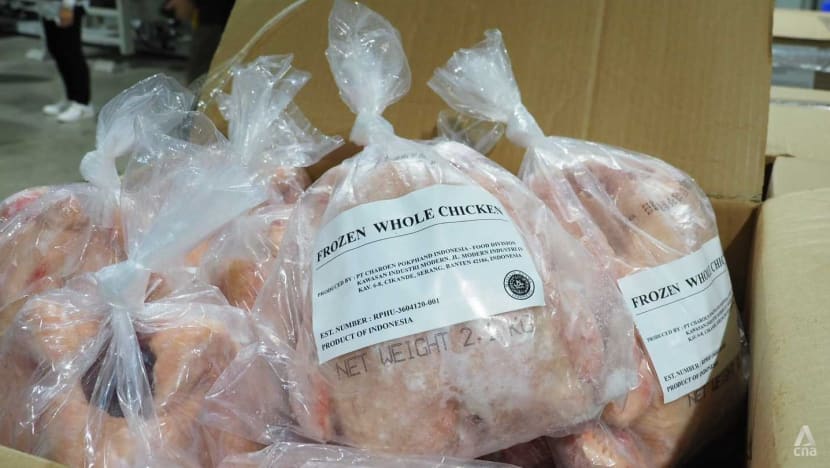Commentary: Ruffled feathers in chicken export competition between Malaysia and Indonesia
Malaysia’s ban on chicken exports to Singapore has allowed Indonesia to join the competitive poultry export market, but in the long run, Indonesia will be able to compete only if it can find a way to transport live chickens to Singapore, say these writers.

SINGAPORE: Malaysia’s decision to limit its export of chicken to overseas markets to secure its domestic needs has disrupted the food supply chain in neighbouring countries. However, this move has created opportunities for other countries, including Indonesia, to fill the void and compete in the chicken export sector.
Malaysia halted chicken exports to Singapore from Jun 1 due to domestic price hikes and limited supply. The government implemented its export ban, which affected volumes of around 3.6 million chickens per month, to ensure that domestic needs were fully safeguarded going into the Eid al-Adha festive season.
The move was meant to be short-term, in response to lower chicken production that affected prices and supply. While it was perceived as critical to stabilising prices within Malaysia, there was no apparent impact on the price of chicken in Malaysia initially but the ban greatly impacted Singapore, one of the key Malaysian markets for chicken export.

Singapore is deeply reliant on imported food. For its poultry needs, up to 34 per cent is imported from Malaysia, while 49 per cent comes from Brazil and 12 per cent from the United States. Most of the chicken Singapore imported from Malaysia was imported live, unlike the frozen imports from the other two major suppliers.
To fill the gap, Singapore has increased imports of chicken meat from Thailand and Indonesia. Interestingly, Indonesia had never exported chicken to Singapore until now. This is despite Indonesia having an oversupply of chicken. Under normal conditions, it can produce around 280 million to 300 million live chickens per month (about 75 million birds per week).
DEMAND FOR EXPORT LICENCES
For many years, Indonesia lacked the access to supply chicken to Singapore. Sourcing live chickens from Malaysia is more straightforward and cheaper, given that supplies can be trucked in over land; shipping it by sea from even Indonesia’s nearest islands would add to costs for such a volume of imported poultry.
However, Singapore has had to find a workaround after Malaysia’s ban affected local businesses and households significantly. On Jun 30, the Singapore Food Agency (SFA) approved imported frozen, chilled and processed chicken meat from Indonesia.
It will take time before Indonesia claims its place as a competitive exporter of chicken meat to Singapore. Currently, only three companies have obtained approval from the SFA: Charoen Pokphand Indonesia-Food Division, Ciomas Adisatwa-Plant Pemalang, and Charoen Pokphand Indonesia (CPIN).
Charoen Pokphand Indonesia and Ciomas Adisatwa obtained approvals to export frozen chicken meat and chicken pieces, while CPIN got a licence to export processed chicken meat. Interestingly, all three companies are related to agri-food giants, Thailand’s Charoen Pokphand and Japfa, a Singapore-based agri-food company. This indicates the importance of foreign investment in Indonesia’s food and agricultural sectors.
According to the Director of Processing and Marketing of Livestock Products at the Directorate-General of Animal Husbandry (PKH) in Indonesia’s Ministry of Agriculture, there are at least 10 more big companies in line for receiving export licenses.

For Singapore, adding Indonesia to its list of suppliers for poultry meat will increase its food resilience. For Indonesia, the benefit might extend beyond the Singapore market and open up export opportunities to other Southeast Asian markets, including Brunei and ironically, Malaysia.
When the new arrangement was launched, Indonesian Agriculture Minister Syahrul Yasin Limpo cited Singapore’s strict standards for food imports and expressed hope that this first shipment to Singapore “will boost the confidence of other countries towards Indonesian food products”. In short, this export push might lead Indonesia’s poultry breeders to raise their quality standards.
RISKS IN EXPORTING LIVE CHICKENS
According to Indonesia’s Ministry of Agriculture, Indonesia’s chicken meat production throughout 2022 is expected to reach 5.9 million tonnes when domestic demand is expected to be just 5.3 million tonnes. This would give Indonesia a surplus of around 50,000 tonnes per month and exporting this surplus can help stabilise domestic prices, which would benefit chicken breeders.
Yet, there are challenges for Indonesia, especially that of figuring out how to export live chickens to Singapore across the seas. There is a high risk that a significant part of each shipment could be lost (through death or injury of livestock) when moving it from the centre of production on Java island, which accounts for 60 per cent of total chicken production in Indonesia, to Singapore.
Malaysia has already partially lifted its ban by allowing poultry producers and importers in Singapore to bring in live free-range chickens. On Aug 1, Malaysia announced that its chicken supply had stabilised and that it now can export the surplus. However, no actual lifting of the full ban has been declared.
If Singaporean consumers find that Indonesia’s chickens are of similar quality and are reasonably priced compared to Malaysia’s, Singapore will likely continue to import from Indonesia no matter what Malaysia does. However, Indonesia will find tough competition against Malaysia and Thailand in the poultry market.
Singapore already has an adequate supply of frozen chicken. When Malaysia lifts its ban, Singapore will continue to rely on Malaysia for live chickens. In the long run, Indonesia can only compete in chicken exports if it can somehow export live chickens to Singapore. The ongoing discussions to set up chicken farms in Batam is only the first step in making this possible.
Whether Indonesia is prepared to compete with Malaysia in this sector, Southeast Asian countries are likely to continue to diversify their food supply given the vagaries of climate change and global instability.
Siwage Dharma Negara is senior fellow and coordinator of the Indonesia Studies Programme, and the coordinator of the APEC Study Centre at ISEAS - Yusof Ishak Institute.
Peh Ko Hsu is an undergraduate in Nanyang Technological University's Bachelor of Social Science in Economics programme, and a research intern with ISEAS - Yusof Ishak Institute.
This commentary first appeared on ISEAS-Yusof Ishak Institute blog The Fulcrum.

















